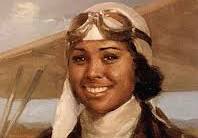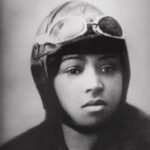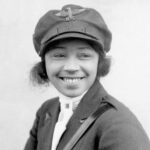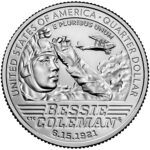
Bessie Coleman is not exactly a byword in most homes, but in some circles she's a glittering star.
Born in Atlanta, TX, in 1892, Coleman became the first African-American/Native American woman to hold a pilot license. Her sharecropper father was of Cherokee descent and her mother African-American. She earned her license from the French Fédération Aéronautique Internationale in 1921, and was also the first Black person to earn an international pilot's license.
Growing up, Coleman had to drop out of school every year during cotton-picking season. Despite the setbacks, she graduated and completed one year of college.
At 23, she followed her brothers to Chicago and worked as a manicurist at the White Sox Barber Shop, where she heard stories of flying during wartime from pilots returning home from World War I.  Fascinated, she worked two jobs to save money in hopes of becoming a pilot herself. At that time, American flight schools admitted neither women nor black people. With financial sponsorship from Jesse Binga (founder of the first privately owned African-American bank in Chicago) and the Defender Newspaper (aka "America's Black Newspaper" in the early 20th century), she set her eye on the Caudron Brothers' School of Aviation in France.
Fascinated, she worked two jobs to save money in hopes of becoming a pilot herself. At that time, American flight schools admitted neither women nor black people. With financial sponsorship from Jesse Binga (founder of the first privately owned African-American bank in Chicago) and the Defender Newspaper (aka "America's Black Newspaper" in the early 20th century), she set her eye on the Caudron Brothers' School of Aviation in France.
After taking French classes at the Berlitz Language School in Chicago Coleman traveled to Paris, where she learned to fly in a Nieuport 564 biplane with "a steering system that consisted of a vertical stick the thickness of a baseball bat in front of the pilot and a rudder bar under the pilot's feet." She was awarded her license on June 15, 1921.
Commercial aviation was still in its earliest stages and, after returning to the U.S., Coleman quickly realized that in order to make a living she would have to become a "barnstorming" stunt flier, performing dangerous tricks in the air for paying audiences. Her flying knowledge was

insufficient for the task. In February 1922, she sailed again for Europe and spent two months completing an advanced course in aviation before returning home to launch her career in exhibition flying and fulfill her dream of one day opening a school for African-American fliers.
She was a huge draw at aviation shows and quickly gained a reputation as a skilled and daring pilot who would stop at nothing to complete a difficult stunt. The papers were soon calling her "Queen Bess" and "Brave Bessie."
Stunt flying was thrilling, but also dangerous. At a 1923 Los Angeles show, she broke a leg and three ribs when her plane stalled and crashed.
Coleman died in a plane crash in 1926 in Jacksonville, FL, when her plane unexpectedly went into a dive and spun out at 3,000 feet above the ground. She was thrown from the plane at 2,000 ft and killed instantly when she hit the ground. Investigators later discovered that a wrench used to service the engine had jammed the controls. Coleman was 34 years old.
On January 3, 2023, the U.S. Mint shipped the first of its American Women Quarters — a coin honouring Bessie Coleman. Subsequent quarters will honour Edith Kanaka’ole, an indigenous Hawaiian composer; former first lady Eleanor Roosevelt; Mexican American journalist, suffragist and civil rights activist Jovita Idar; and Maria Tallchief, our nation’s first Native American prima ballerina.
